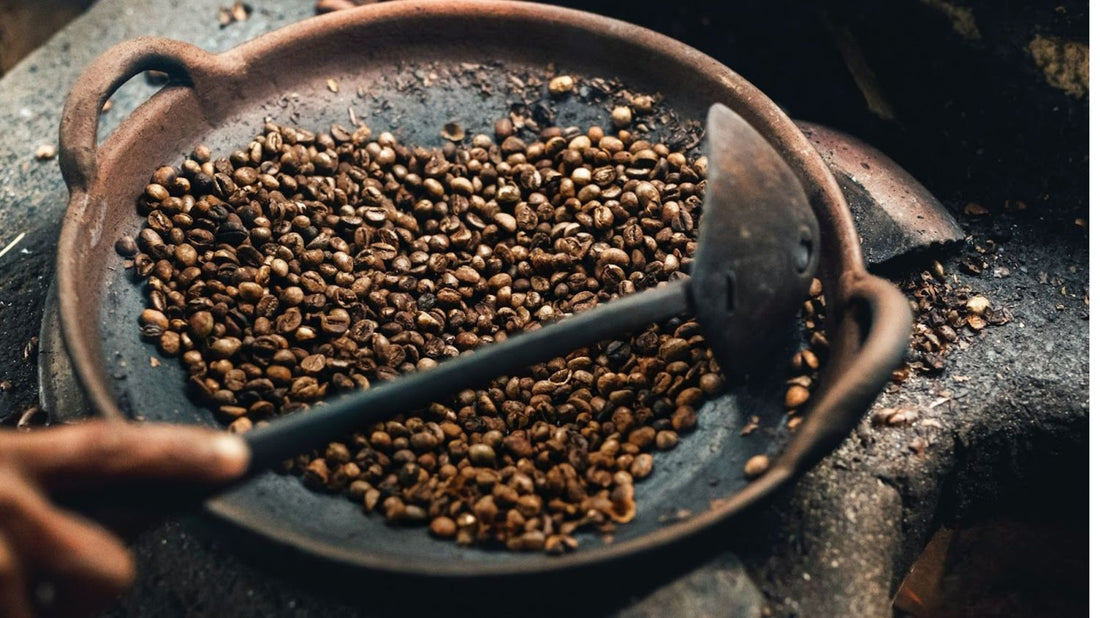
What is roasting: releasing flavors through heat
Share
Introduction to roasting
Roasting is the process of cooking certain foods at precise temperatures to develop subtle caramel and toasted flavors.
It is possible to roast flour, cereals, nuts, and of course, coffee beans.
Roasting is a complex process that has evolved over the centuries to become a true science.
Together, we'll explore the history of roasting, different roasting methods, what a roaster is, and precise flavor profiles.
The history of roasting
The first traces of coffee roasting date back to the 13th century, where the Arabs began roasting coffee beans to extract their aromas and flavor.
At that time, the beans were roasted in holey pans over a charcoal fire. Since then, coffee roasting has evolved into a true art and industry.
The different roasting methods
There are several methods of roasting coffee, nuts, and grains, depending on the ingredient chosen and the desired result. The most common method is hot air roasting, where hot air is forced through and allows for even roasting. This requires a roaster to have equal results with each roast.
What is a roaster?
There are different types of roasters.
- The drum roaster: heat is injected into a rotating drum. This heat is indirect, it does not affect the ingredients to be roasted.
- The hot air roaster: In a large vat, jets of heat are injected directly onto the beans and blades turn the beans.
- The flash roaster: the coffee beans are placed on a belt, and will pass through a cooking chamber. The roasting degrees are very high and allow the product to be roasted very quickly. This method is used by major industrial brands because it requires very little cooking time.
The roasting process
The roasting process is divided into several stages. First, we increase the temperature of the roaster to release the humidity. Then the internal sugars in the ingredients begin to caramelize, called the Maillard reaction, and release flavors. Once the desired roasting stage has been reached, depending on the desired flavor profile, we move on to the cooling stage which stops the roasting process.
Taste profiles
Light to medium roast
The lighter the roast, the lighter and more tangy the taste will be.
Tart does not mean bitter. It's more about tastes that are closer to lemony, almost fruity notes.
Medium to very dark roast
The darker the roast, the more full-bodied and intense the aromas will be, with notes of chocolate and caramel.
It is possible that the taste is more bitter, and that the true aromas are masked by a cooked and burnt taste.
In addition, certain techniques, such as slow roasting, allow you to develop more complex and subtle flavors.
Roasted cereals and chicory
Cereals and chicory are often used as coffee substitutes because the complexity of their flavors is similar to the coffee profile.
Grains, like barley and rye, provide notes of toast and cereal, while chicory has a touch of bitterness and roastiness.
Roasting fruit?
For our part, we like to roast fruits, this allows us to have a slightly fruity and caramelized taste without losing the antioxidants which remain present despite roasting. We have created several beverages using roasted fruits, such as cranberries and blueberries. This way we have benefits in addition to drinking something comforting.
To find out more click here: https://siffleux.ca/products/le-pop
Roasting your beans at home
A popular method for roasting a small batch at home is pan roasting. This method offers precise control over roasting, but requires constant attention to avoid burning your beans.
Several roasting techniques are explained in the book of Siffleux .
In the last section, we find tips for making your own coffee alternative with beans, cereals and all kinds of special ingredients.
To find out more click here: https://siffleux.ca/pages/livre-de-recettes
